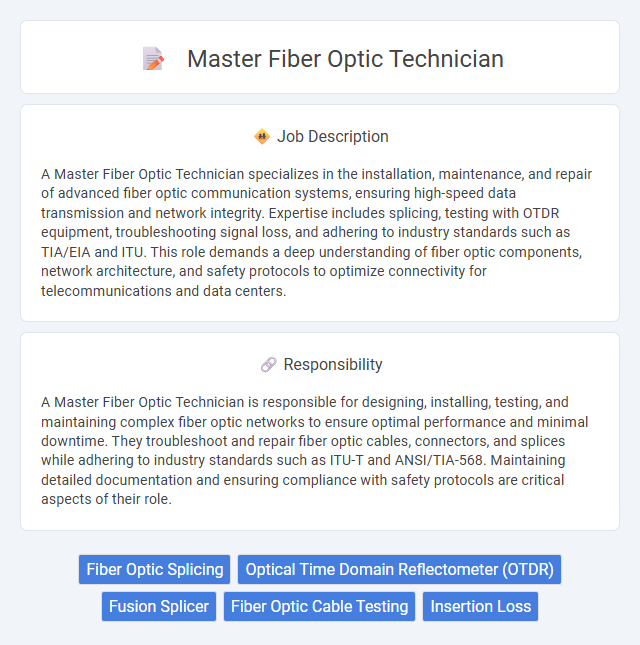
A Master Fiber Optic Technician specializes in the installation, maintenance, and repair of advanced fiber optic communication systems, ensuring high-speed data transmission and network integrity. Expertise includes splicing, testing with OTDR equipment, troubleshooting signal loss, and adhering to industry standards such as TIA/EIA and ITU. This role demands a deep understanding of fiber optic components, network architecture, and safety protocols to optimize connectivity for telecommunications and data centers.
Individuals with strong problem-solving skills and an aptitude for working in high-pressure environments will likely find success as master fiber optic technicians. Those who are comfortable with precise, hands-on tasks and willing to work in various weather conditions may be well-suited for this role. Candidates who prefer routine indoor work or lack technical curiosity may have a lower probability of thriving in this demanding and dynamic field.
Qualification
Master fiber optic technicians require advanced certification such as ETA FOT Master or equivalent industry credentials demonstrating expertise in fiber optic installation, maintenance, and troubleshooting. Proficiency in interpreting complex schematics and utilizing tools like fusion splicers, OTDRs (Optical Time Domain Reflectometers), and power meters is essential. Extensive field experience combined with knowledge of industry standards, such as ANSI/TIA-568 and ISO/IEC 11801, ensures comprehensive qualification for overseeing fiber optic network projects.
Responsibility
A Master Fiber Optic Technician is responsible for designing, installing, testing, and maintaining complex fiber optic networks to ensure optimal performance and minimal downtime. They troubleshoot and repair fiber optic cables, connectors, and splices while adhering to industry standards such as ITU-T and ANSI/TIA-568. Maintaining detailed documentation and ensuring compliance with safety protocols are critical aspects of their role.
Benefit
Master fiber optic technicians probably enjoy increased earning potential due to their advanced expertise in fiber optic networks. They likely benefit from greater job security as demand for skilled professionals in telecommunications continues to grow. Opportunities for career advancement and specialized project roles may also be more accessible to those with master-level certifications.
Challenge
A Master Fiber Optic Technician will likely face complex challenges involving the installation, testing, and maintenance of high-speed fiber optic networks. Troubleshooting signal issues and ensuring minimal downtime may require advanced problem-solving skills and up-to-date technical knowledge. The role probably demands adapting to rapidly evolving technology and stringent industry standards to maintain optimal network performance.
Career Advancement
A Master Fiber Optic Technician demonstrates advanced expertise in fiber optic installation, splicing, testing, and troubleshooting, positioning themselves for leadership roles in telecommunications and network infrastructure projects. Mastery of industry standards such as ANSI/TIA-568 and proficiency with cutting-edge equipment enhances opportunities for promotion to supervisory or project management positions. Continuous skill development and certification acquisition, like ETA or FOA credentials, enable career growth into senior technical roles or specialized consulting in fiber optic technologies.
Key Terms
Fiber Optic Splicing
Master fiber optic technicians specialize in precision fiber optic splicing, ensuring optimal signal transmission and minimal loss in communication networks. They utilize advanced fusion splicing machines and techniques to join fiber strands with high accuracy, critical for maintaining network integrity in telecommunications and data centers. Expertise in fiber optic splicing directly impacts network performance, reliability, and troubleshooting efficiency.
Optical Time Domain Reflectometer (OTDR)
Master fiber optic technicians specialize in advanced testing and troubleshooting of fiber optic networks using Optical Time Domain Reflectometers (OTDR). They interpret OTDR traces for precise fault location, splice loss measurements, and fiber characterization to ensure optimal network performance. Expertise in OTDR technology enables accurate detection of fiber breaks, connectors, and bends, critical for maintaining high-speed communication infrastructure.
Fusion Splicer
A Master Fiber Optic Technician specializes in advanced installation and maintenance of fiber optic networks, with expertise in fusion splicing to ensure minimal signal loss and optimal network performance. Proficiency in handling fusion splicers, such as Fujikura and Sumitomo models, allows precise alignment and joining of optical fibers, critical for high-speed telecommunications and data transmission. Mastery of fiber preparation, splicing parameters, and quality testing guarantees durable splices that meet industry standards like Telcordia and ANSI/TIA.
Fiber Optic Cable Testing
A Master Fiber Optic Technician specializes in advanced fiber optic cable testing, utilizing equipment such as OTDRs (Optical Time Domain Reflectometers) and power meters to ensure network integrity and performance. Expertise includes identifying faults, measuring attenuation, and certifying cable installations according to industry standards like ANSI/TIA-568. Proficient testing guarantees optimal signal transmission, reducing downtime in telecommunications and data center infrastructures.
Insertion Loss
A Master Fiber Optic Technician specializes in minimizing insertion loss to ensure optimal network performance and high signal integrity. Precise measurement and management of insertion loss, typically using an optical power meter and light source, are critical for maintaining efficient data transmission across fiber optic networks. Mastery of testing procedures and troubleshooting techniques directly contributes to reducing signal degradation and enhancing overall system reliability.
 kuljobs.com
kuljobs.com